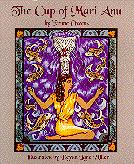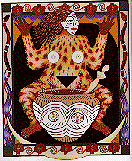

![]()

|
The Cup of Mari Anu.
Yvonne Owens. Illustrated by Kevan Lane Miller.
Grades 4 - 7 / Ages 9 - 12.
|
excerpt:
She learned that there are many chalices in the world like the Cup of Mari Anu and the Holy Grail of the Isle of Women, and that they are a sacred trust of all women. They represent the actual essence of women as the symbols of women's sacred nature. The Cups mean many things to different people. They signify the cauldron of the belly, the womb, and creativity. They are symbols of nurture and of life itself. Lu Sin learned that the Cups exist wherever this awareness exists . . . And she learned that wherever this awareness is not, the Cup of Life exists not, for treasures can be lost or stolen or disappear. Rivers, lakes and the entire oceans can become poisoned and die.
 Yvonne Owens draws on her lifelong study of mythology, adding elements from folklore, shamanism, and magic, to tell the story of Lu Sin and the wild dog, a story in the pattern of the Holy Grail myth.
Yvonne Owens draws on her lifelong study of mythology, adding elements from folklore, shamanism, and magic, to tell the story of Lu Sin and the wild dog, a story in the pattern of the Holy Grail myth.


Recommended.
Maryleah Otto is a former children's librarian in Toronto and London, Ontario. She has had four books for children published since 1985.
The Cup of Mari Anu was reviewed by classes across Canada as part of the Collaborative Book Review Project. You can read the students' reviews at the Collaborative Book Review Project site.
To comment on this title or this review, send mail to cmeditor@mts.net.
![]()
Copyright © 1996 the Manitoba Library Association.
Reproduction for personal use is permitted only if this copyright notice
is maintained. Any other reproduction is prohibited without permission.
Published by
The Manitoba Library Association
ISSN 1201-9364
![]()